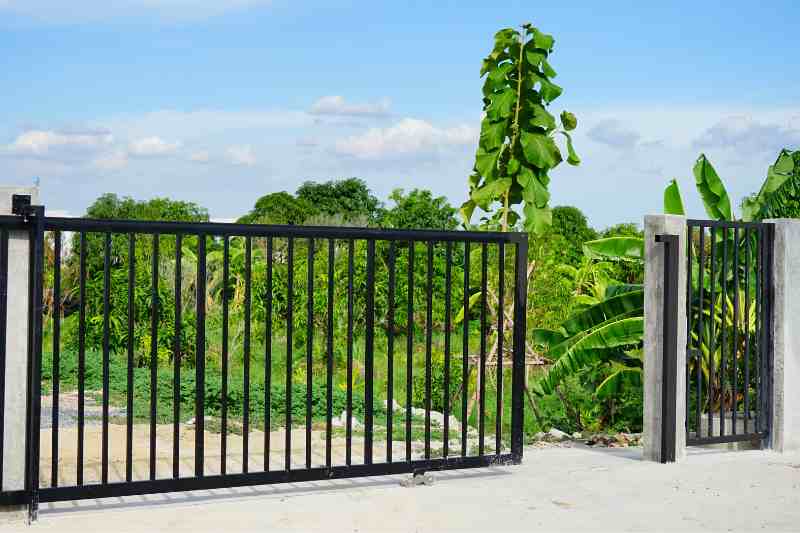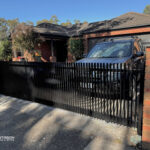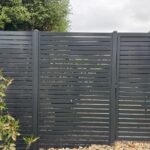
There is nothing wrong with enhancing your security features, whether for your home or business estate. It’s a great way to keep intruders off your property and while controlling access. Gates not only serve security but also add aesthetic appeal, representing your desired image when chosen wisely. There are two primary gate options: sliding and swing gates. The right choice depends on factors like property size, budget, and purpose. If you’re unsure which to install, read on for a clear comparison.
If you’ve ever wondered about the peculiar name “sliding gate” and what sets it apart from other gate types. Sliding gates, as the name suggests, have a unique operating mechanism that distinguishes them from their swinging counterparts. In this blog post, we’ll delve into the definition of a sliding gate and explore its advantages and disadvantages.
What is a Sliding Gate?

A sliding gate often referred to as a slide gate, is a type of gate that operates horizontally along a track to open and close. Unlike traditional swing gates that pivot on hinges, sliding gates move parallel to the fence or wall they are attached to. This mechanism allows them to slide open and closed smoothly, making them an ideal choice for various applications.
Advantages of Sliding Gates
Space Efficiency
One of the most significant advantages of sliding gates is their space-saving design. Since they don’t swing inward or outward like traditional gates, they are perfect for properties with limited space or steep driveways.
Smooth Operation
Sliding gates are known for their smooth and silent operation. They glide effortlessly along their tracks, making them less prone to wear and tear compared to swinging gates.
Security
Sliding gates provide a high level of security. They are challenging to force open, making them an excellent choice for enhancing property security.
Aesthetics
Sliding gates can be designed to complement the aesthetics of your property. They come in various materials, styles, and finishes, allowing you to choose one that matches your architectural preferences.
Remote Control
Many sliding gates can be automated and operated remotely using a remote control or smartphone app, adding convenience to your daily life.
Disadvantages of Sliding Gates
Initial Cost
The installation of a sliding gate, especially if automated, can be more expensive than a swinging gate. However, this cost may be offset by the long-term benefits.
Maintenance
Sliding gates require regular maintenance, particularly the tracks and rollers, to ensure smooth operation. Neglecting maintenance can lead to operational issues.
Power Dependency
Automated sliding gates rely on electricity to function. In the event of a power outage, manual operation might be required.
Track Obstacles
Any obstruction on the track can hinder the gate’s movement. It’s essential to keep the track clear of debris and obstacles.
When choosing between a sliding gate and other gate types, carefully evaluate your property’s specific needs and constraints to make an informed decision. Whether you opt for a sliding gate or another type, enhancing your property’s security and aesthetics is a step in the right direction.
What is a Swing Gate?

A swing gate often referred to simply as a “swing gate,” is a type of gate that operates on hinges, similar to how a door swings open and closed. These gates are commonly found in residential properties, commercial spaces, and even industrial settings. The defining feature of a swing gate is its pivoting motion, which allows it to swing open or shut along a fixed axis.
Advantages of Swing Gates
Classic Aesthetics
Swing gates exude a timeless charm and elegance. They can enhance the overall look of your property, providing a traditional and welcoming feel.
Durability
These gates are typically built to last. They are made from sturdy materials such as steel, wrought iron, or aluminum, ensuring they can withstand the test of time and weather conditions.
Smooth Operation
Swing gates operate smoothly and quietly. They’re easy to open and close manually, making them user-friendly.
Customization
You have the flexibility to customize the design of swing gates to match your property’s aesthetics. Whether you prefer a simple and sleek design or ornate embellishments, the choice is yours.
Security
Swing gates can be equipped with secure locking mechanisms, adding an extra layer of security to your property.
Disadvantages of Swing Gates
Space Requirements
One significant drawback of swing gates is the space they require to operate. Since they swing open and closed along a horizontal axis, you need to ensure there’s enough clearance in the direction of the swing.
Uneven Terrain Challenges
If your property has uneven terrain or slopes, installing a swing gate can be more complicated and costly. The gate may need additional mechanisms to ensure proper operation.
Maintenance
While swing gates are durable, they still require regular maintenance to keep them in good condition. This includes lubricating hinges, repainting, and addressing any wear and tear.
Cost
Depending on the material and design, swing gates can be relatively expensive to install, especially when compared to simpler gate types like chain-link or sliding gates.
What Is the Difference Between a Swing Gate And a Sliding Gate?
The primary difference between a swing gate and a sliding gate lies in how they operate and move to provide access control. Here are the key distinctions
Space Requirement
Swing Gate: Swing gates need clearance space to open either inward or outward. If your property has limited space, this can be a significant drawback as they may not be suitable.
Sliding Gate: Sliding gates, as mentioned earlier, are space-efficient since they move horizontally along a track. This makes them an excellent choice for properties with narrow driveways or limited clearance.
Cost Considerations
Swing Gate: Swing gates are generally more cost-effective both in terms of installation and maintenance. They are simpler in design and require fewer components.
Sliding Gate: Sliding gates, particularly if automated, can be pricier to install due to the track system and motorized mechanism. However, they may offer long-term benefits that justify the initial cost.
Maintenance Needs
Swing Gate: Swing gates have fewer components that require maintenance. They don’t have tracks and rollers, which are common wear-and-tear points in sliding gates.
Sliding Gate: Sliding gates need periodic track and roller maintenance to ensure smooth operation. Neglecting maintenance can lead to operational issues.
Security Levels
Swing Gate: While swing gates can provide security, they may be considered less secure than sliding gates. Intruders could potentially force them open with enough effort.
Sliding Gate: Sliding gates are inherently more secure due to their design. It’s challenging for intruders to force them open, making them a preferred choice for enhanced security.
Aesthetics and Design Flexibility
Swing Gate: Swing gates offer a traditional and classic appearance. They may not provide the same level of design flexibility as sliding gates but can still be customized to match your property’s style.
Sliding Gate: Sliding gates come in various materials, styles, and finishes, allowing for greater design customization. They can be a better fit if aesthetics are a priority.
Power Dependency
Swing Gate: Swing gates do not rely on electricity for operation, making them accessible during power outages.
Sliding Gate: Automated sliding gates depend on electricity. If the power goes out, manual operation may be necessary.
The choice between a swing gate and a sliding gate depends on your specific needs and constraints. Consider factors such as available space, budget, maintenance capabilities, security requirements, and design preferences when making your decision. Both gate types have their strengths and weaknesses, so it’s essential to evaluate which one aligns better with your property and priorities.
Conclusion
The decision between a sliding gate and a swing gate ultimately boils down to your specific needs and property constraints. Each gate type has its own set of advantages and disadvantages. Sliding gates are ideal for properties with limited space, thanks to their horizontal movement along a track. They offer a sleek and modern appearance, enhanced security, and convenient remote operation, but they can be costlier to install and require regular track maintenance.
On the other hand, swing gates, which pivot open like traditional doors, are a cost-effective option with simpler maintenance needs. They are a practical choice when space isn’t an issue but may not offer the same level of security and design flexibility as sliding gates. Ultimately, the better choice depends on your property’s unique requirements, budget, and aesthetic preferences.




